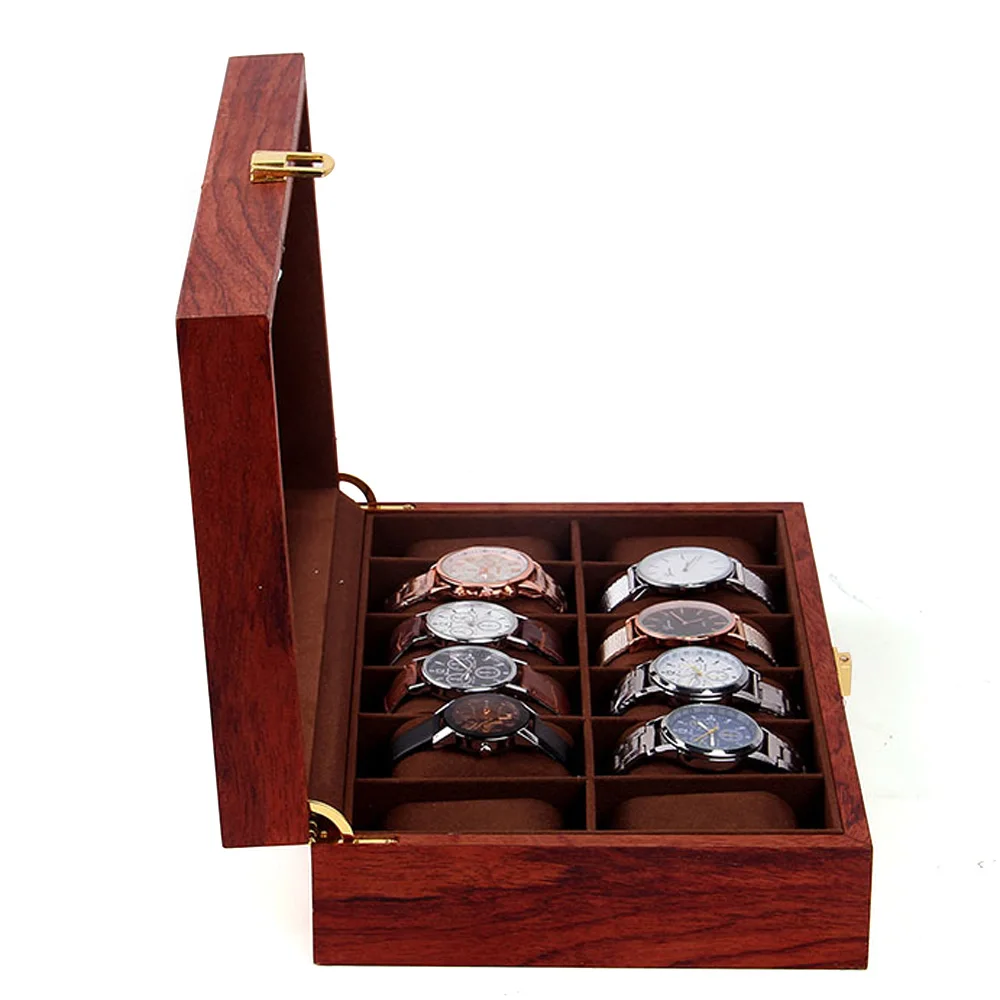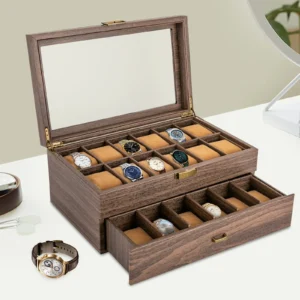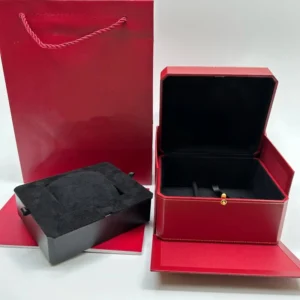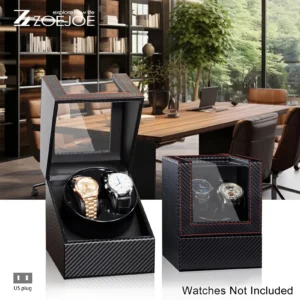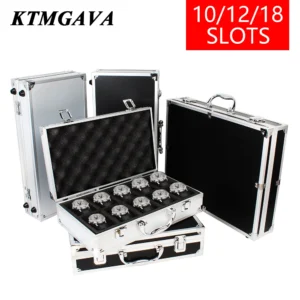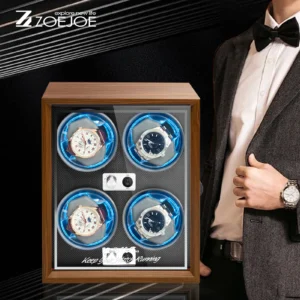Introduction: The Foundation of Your Watch Collection’s Home
A watch box serves as more than just storage for your timepieces—it’s a protective vault, a display showcase, and often a statement piece within your home. These specialized containers are designed to safely house your watches while preserving their condition and showcasing their beauty.
When selecting a watch box, the materials used in its construction play a crucial role in determining not only how well it protects your collection but also how it complements your personal style. The right materials can prevent scratches, minimize dust accumulation, regulate humidity, and even enhance the visual appeal of your timepieces.
From traditional hardwoods to modern carbon fiber, leather to velvet, each material brings unique properties to your watch collection storage planning. Some materials excel at protection, others at presentation, while the best options often balance both needs effectively.
As we explore the various materials used in watch boxes—from exterior construction to interior lining—you’ll discover how each choice impacts both the functionality and aesthetics of these specialized storage solutions. Whether you’re protecting a single precious timepiece or an extensive collection, understanding these materials is the first step toward making an informed purchase decision.
Wood: The Classic Choice for Timeless Protection
Wood remains the quintessential material for watch boxes, offering a perfect blend of natural beauty and protective qualities. The timeless appeal of wooden watch boxes stems from their rich grain patterns, warm tones, and substantial feel. These boxes provide an elegant home for treasured timepieces while complementing virtually any interior design style.
Several wood varieties are commonly used in crafting premium watch boxes:
- Oak: Known for its distinctive grain pattern and exceptional durability, oak provides excellent stability and resistance to warping.
- Walnut: Prized for its rich, dark brown color that deepens beautifully with age, walnut offers natural shock absorption properties.
- Cherry: Features a warm reddish hue that continues to darken over time, creating a distinguished patina.
- Mahogany: Delivers a luxurious reddish-brown color with straight grain patterns and excellent workability.
Beyond solid hardwoods, many manufacturers use engineered wood products like MDF (Medium Density Fiberboard) with high-quality veneers. These provide the aesthetic appeal of premium woods while often offering improved stability and resistance to environmental changes.
The benefits of wooden watch boxes extend beyond their visual appeal. Wood naturally regulates humidity to some degree, creating a more stable environment for mechanical watches. The substantial weight of hardwood boxes also provides security, preventing accidental tipping or movement.
However, wood does require some consideration. These boxes tend to be heavier than alternatives, making them less ideal for travel. They also require occasional maintenance with appropriate wood treatments to prevent drying or cracking, especially in very dry or humid environments.
The finishing process—whether lacquer, oil, or wax—not only enhances the wood’s natural beauty but also provides crucial protection against moisture and environmental damage, ensuring your watch box remains as timeless as the pieces it protects.
Leather and Synthetic Alternatives: Luxurious Touch and Versatility
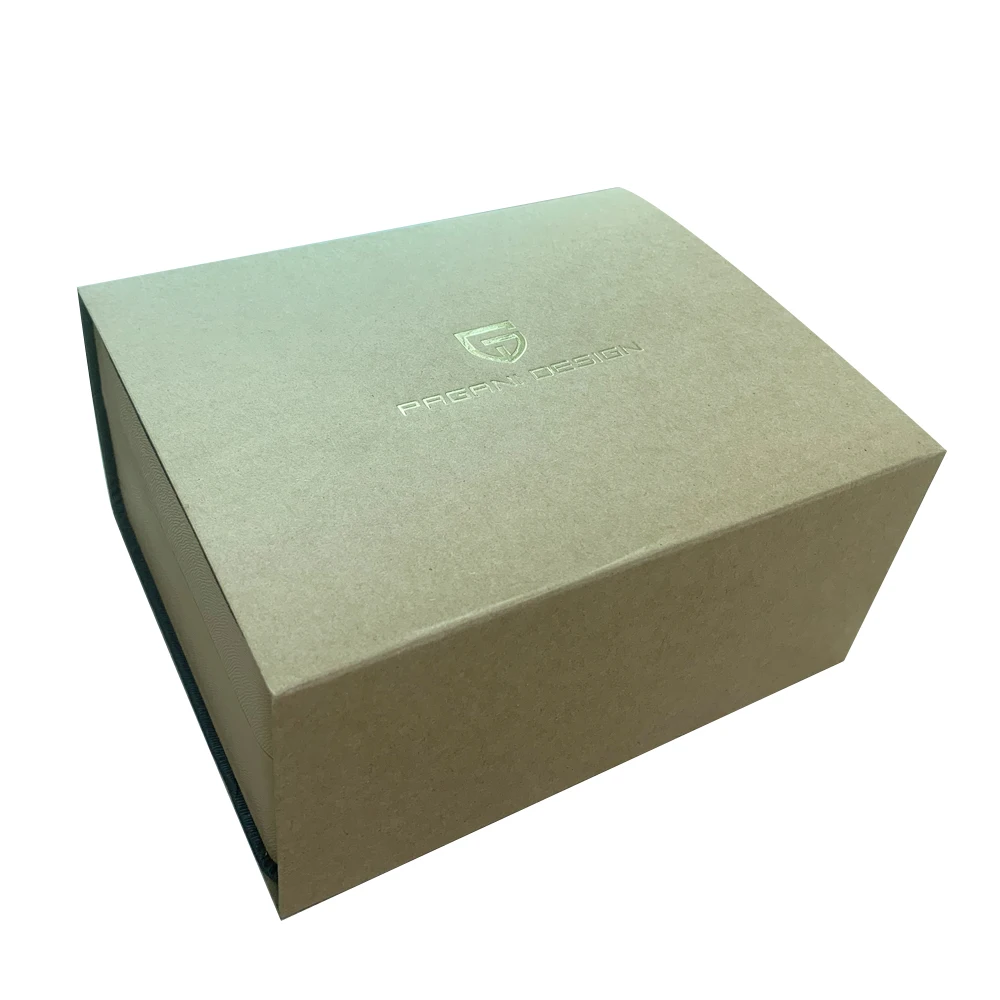
Leather watch boxes offer a distinctly luxurious aesthetic with their supple texture and rich appearance. The tactile experience of opening a leather watch box adds an element of ceremony to accessing your timepieces, making each interaction feel special.
The world of leather watch boxes encompasses several distinct varieties:
Genuine Leather Options:
– Full-grain leather: The highest quality option, featuring the complete grain of the hide with all natural markings. This leather develops a beautiful patina over time and offers superior durability.
– Top-grain leather: Slightly processed to remove imperfections while maintaining excellent durability and a more uniform appearance.
– Corrected-grain leather: More heavily processed with an artificial grain applied to the surface, providing consistency but with less character development over time.
Alternative Options:
– Bonded leather: Created from leather scraps bound together with adhesives. While affordable, it lacks the durability of genuine leather and may deteriorate more quickly.
– PU leather (polyurethane): A synthetic alternative that mimics the look of leather without animal products. Modern PU leather options offer impressive visual similarity to genuine leather with benefits like water resistance and consistent coloration.
Leather watch boxes excel in providing a soft exterior that won’t scratch other items placed nearby. Their flexible nature also allows for innovative designs that might not be possible with rigid materials. Many high-end boxes feature leather exteriors paired with plush interiors for comprehensive protection.
However, leather requires different care considerations than wood. Genuine leather needs occasional conditioning to prevent drying and cracking, while both real and synthetic leathers can be susceptible to scratching or staining. With proper leather watch box maintenance, these materials can retain their beauty for many years.
The aging characteristics of different leather types also merit consideration. While full-grain leather develops a desirable patina that many collectors appreciate, synthetic alternatives maintain a more consistent appearance throughout their lifespan. This makes material selection largely a matter of personal preference and intended use.
Leather watch boxes bridge the gap between traditional and contemporary aesthetics, making them versatile options that complement virtually any watch collection or home décor style.
Modern Materials: Carbon Fiber, Metal, and Composites
Today’s watch boxes increasingly incorporate advanced materials that offer unique benefits for modern collectors. These contemporary options provide alternative aesthetics and specialized protective qualities.
Carbon Fiber
Carbon fiber watch boxes represent the cutting edge of lightweight durability. This advanced material features a distinctive woven pattern that creates a sophisticated, technical appearance appealing to collectors of sports and modern timepieces.
The benefits of carbon fiber include:
– Exceptional strength-to-weight ratio, making these boxes incredibly lightweight yet protective
– Inherent resistance to impacts and pressure
– Modern aesthetic that complements contemporary watches and décor
The primary considerations for carbon fiber include its premium price point and somewhat limited aesthetic variations compared to natural materials.
Metal (Aluminum, Stainless Steel)
Metal watch boxes deliver an industrial aesthetic coupled with unmatched structural integrity. These robust containers often feature in high-security applications or as travel cases where maximum protection is essential.
Key advantages include:
– Superior resistance to crushing forces
– Excellent security potential when combined with quality locks
– Long-term durability with minimal maintenance requirements
– Modern, sleek appearance
Watch collectors should consider the weight of metal boxes (particularly steel varieties), their potential for surface scratching, and their conductivity of temperature changes, which might affect watches in extreme conditions.
Composites and Hybrid Materials
Modern manufacturing techniques have enabled the development of composite materials that combine the advantages of multiple substances. These hybrid approaches allow watchmakers to create boxes with optimized characteristics for specific needs.
Composite watch boxes might feature:
– Rigid frames with flexible protective layers
– Impact-resistant shells with plush interiors
– Lightweight cores with premium exterior finishes
These innovative combinations often represent the best of both worlds, offering protection without excessive weight or compromised aesthetics.
When organizing watch collection pieces, considering the specific advantages of these modern materials can help determine the ideal storage solution for different timepieces. For example, carbon fiber travel cases might be perfect for sporting watches taken on adventures, while a steel case might offer peace of mind for particularly valuable pieces.
Essential Interior Materials: Where Your Watches Rest

While exterior materials often capture immediate attention, the interior components of a watch box directly contact your timepieces and provide critical protection. These materials deserve careful consideration as they prevent scratches, cushion movements, and create an appropriate microenvironment for valuable watches.
Common Lining Materials:
Velvet: The classic choice for watch box interiors, velvet provides a plush, soft surface that prevents scratching. Its dense pile creates a gentle cushion for watches while adding a luxurious appearance. Typically made from cotton, silk, or synthetic fibers, velvet’s soft texture makes it ideal for protecting polished watch cases and bracelets.
Suede: With a distinctive napped texture different from velvet, suede offers excellent scratch protection with a premium feel. The shorter fibers create a slightly different aesthetic while maintaining excellent protective qualities. Genuine suede comes from leather, while synthetic alternatives mimic the texture without animal products.
Microfiber: This modern synthetic option provides exceptional softness with hypoallergenic properties. Microfiber’s ultra-fine filaments create a surface that’s gentle on delicate watch finishes while offering good resistance to dust accumulation. It’s particularly well-suited for watch boxes that will be opened frequently.
Silk/Satin: Reserved primarily for high-end watch boxes, silk and satin linings provide a smooth, lustrous surface with elegant visual appeal. While less common than velvet, these materials offer a distinctive premium feel that complements luxury timepieces.
Watch Pillows and Cushions:
The pillows or cushions that hold watches in place represent another critical interior component. These pieces typically feature a foam core for structure, wrapped in matching lining material. Quality watch pillows maintain their shape while providing enough flexibility to accommodate different watch sizes and bracelet configurations.
Hardware Components:
Interior quality extends to the hardware elements as well. Hinges should operate smoothly without catching, while clasps and locks should secure firmly without requiring excessive force. Premium watch boxes often feature brass or stainless steel hardware for durability, sometimes with protective coatings to prevent scratches during operation.
The combination of these interior materials works together to create a protective environment where watches remain secure without rubbing against each other or hard surfaces. When evaluating a watch box, paying close attention to these interior elements is just as important as assessing the exterior construction.
Clear Display Components: Showcasing Your Collection
The transparent elements of watch boxes serve a dual purpose: they allow visual appreciation of your collection while still providing physical protection. These display components transform storage solutions into showcase pieces that let you enjoy your watches even when they’re not being worn.
Glass Display Windows
Traditional glass offers exceptional clarity and scratch resistance, making it ideal for displaying premium timepieces. Its weight adds substance to the box, creating a high-quality feel when opening and closing the lid. However, glass is relatively heavy and can shatter if dropped or struck with force. Most quality watch boxes use glass that’s at least 2-3mm thick for adequate durability.
Acrylic/Plexiglass Alternatives
Acrylic (commonly known by brand names like Plexiglass) provides a lightweight alternative to traditional glass. This material offers excellent clarity with significantly improved impact resistance, making it less likely to shatter if accidentally dropped. The primary drawback is its susceptibility to fine scratches over time, though these can often be polished out with specialized products. Modern acrylic formulations have improved considerably in their clarity and durability.
Tempered Glass
For the highest security applications, tempered glass offers substantially improved strength compared to standard glass. When broken, it shatters into small, relatively safe pieces rather than dangerous shards. This specialized glass is often used in high-end watch display case designs where security is a priority alongside visibility.
Maintenance Considerations
All transparent materials require regular cleaning to maintain their clarity. Fingerprints, dust, and environmental residue can accumulate on these surfaces, diminishing the visual impact of your collection. Most materials benefit from cleaning with a slightly damp microfiber cloth, avoiding harsh chemicals that might damage special coatings or the material itself.
Some premium display windows feature anti-reflective coatings that reduce glare, allowing clearer viewing of watch dials and details. These coatings require particularly gentle cleaning to maintain their effectiveness over time.
The choice between glass and acrylic often comes down to priorities: glass offers superior clarity and scratch resistance but adds weight and fragility, while acrylic provides lighter weight and improved impact resistance at the cost of potential fine scratching over time.
Factors Influencing Material Choice for Watch Boxes
Selecting the ideal materials for a watch box involves balancing several important considerations based on your specific needs and preferences. Understanding these factors will help you make an informed decision that serves your collection appropriately.
Aesthetics and Personal Style:
– How the watch box complements your home décor and existing furniture
– Whether you prefer traditional, contemporary, or transitional design language
– Color coordination with your space and other watch accessories
– Texture preferences and how they contribute to the sensory experience
– Visibility requirements (fully enclosed vs. display-oriented storage)
Protection Requirements:
– The total value of your watch collection and associated insurance considerations
– Specific vulnerabilities of your watches (scratch-prone finishes, sensitive movements)
– Environmental concerns in your location (humidity levels, temperature fluctuations, dust)
– Whether the box will remain stationary or travel with you
– Security needs (locks, hidden compartments, weight as theft deterrent)
Durability and Longevity:
– Expected lifespan of the watch box under normal use conditions
– Resistance to environmental factors specific to your location
– How the materials will age (developing character vs. maintaining pristine appearance)
– Structural integrity for the weight and quantity of watches to be stored
– Resistance to accidental damage during normal handling
Maintenance and Care:
– Time you’re willing to dedicate to care and maintenance
– Availability of appropriate cleaning products for specific materials
– Sensitivity to dust and fingerprints
– Requirements for specialized storage conditions
– Resistance to staining from potential exposure to oils or chemicals
The ideal watch box material combination often depends on your specific collection and circumstances. Collectors with valuable vintage pieces might prioritize watch storage ideas collectors that emphasize humidity control and physical protection, while those with modern sports watches might place greater emphasis on security features and contemporary aesthetics.
By carefully weighing these factors against your personal needs, you can identify the material combination that will best serve your collection for years to come.
Material Combinations: Creating the Perfect Watch Box
The most effective watch boxes typically combine multiple materials, leveraging the strengths of each to create optimal storage solutions. These thoughtful combinations enhance both protection and aesthetics while addressing the diverse needs of watch collectors.
A classic and enduring combination pairs wooden exteriors with velvet interiors. The wood provides structural integrity, aesthetic warmth, and a traditional appearance that complements many home environments. Meanwhile, the velvet interior offers gentle cushioning for valuable timepieces, preventing scratches while holding watches securely in place. This pairing works particularly well for dress watches and vintage collections.
For modern sport and tool watches, carbon fiber exteriors with microfiber interiors create a contemporary aesthetic with excellent protection. The lightweight yet strong carbon fiber shell resists impacts during transport, while microfiber interiors prevent scratching of even the most polished surfaces. This combination appeals particularly to collectors of contemporary luxury sports watches.
Leather exteriors paired with suede interiors deliver unmatched tactile luxury. This combination creates a sensory experience each time you access your collection, with the supple leather exterior giving way to the soft touch of suede against your watches. The flexibility of leather also allows for innovative designs like roll cases and travel pouches that aren’t possible with rigid materials.
Glass-top wooden cases represent another effective combination, merging the structural integrity and classic appeal of wood with the display capabilities of glass. These boxes allow visual appreciation of your collection without handling, reducing wear from frequent access while still showcasing your timepieces as decorative elements.
The most versatile combinations often feature wood or leather exteriors, premium fabric interiors, and strategically placed metal hardware for durability at stress points. These thoughtfully designed best wood watch boxes deliver excellent protection with refined aesthetics suitable for most collectors.
By understanding how different materials complement each other, you can select a watch box that provides comprehensive protection while reflecting your personal taste and complementing your home environment.
How to Choose the Right Materials for Your Watch Box
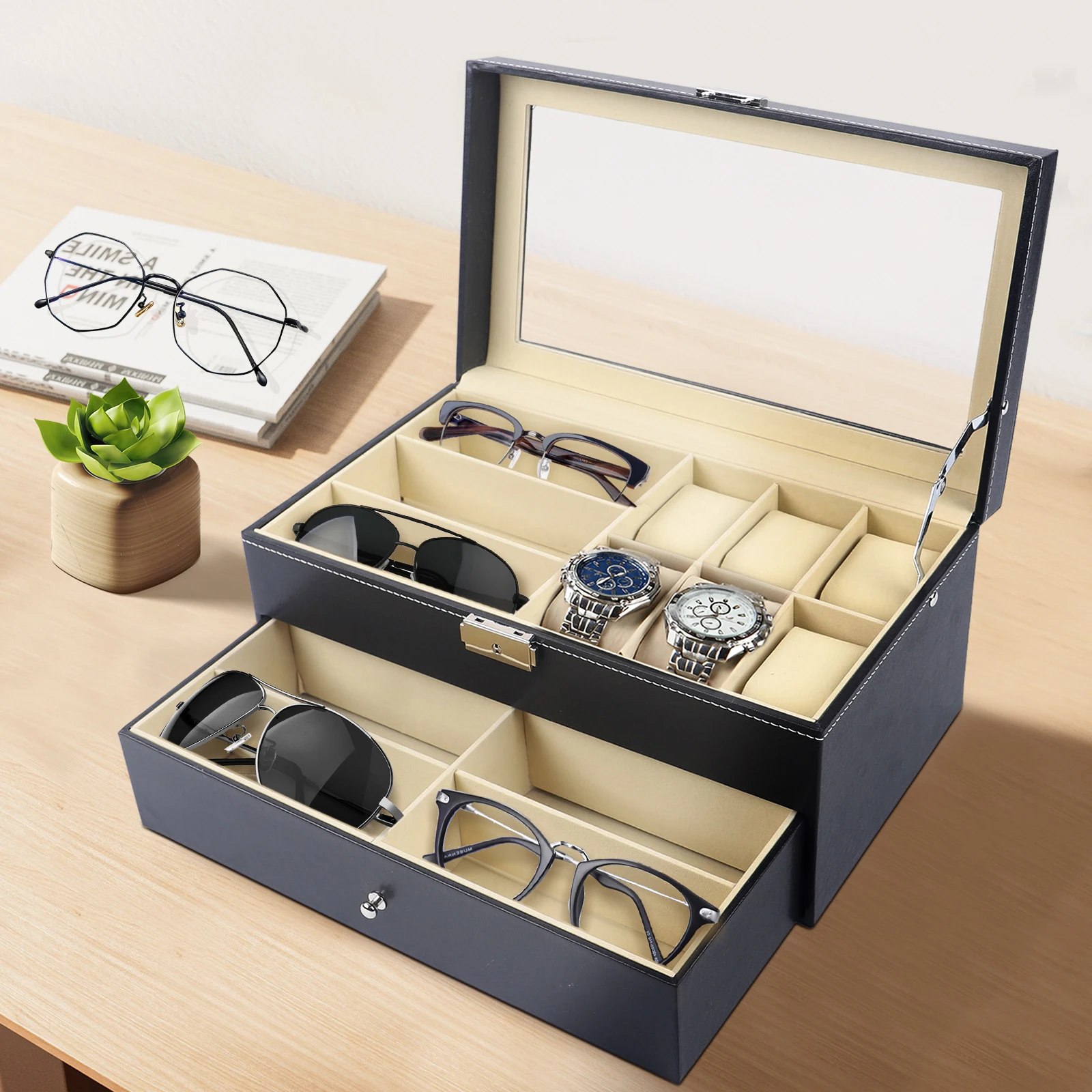
Selecting the perfect watch box materials begins with a thorough assessment of your collection and storage needs. This methodical approach ensures you’ll choose materials that provide appropriate protection while complementing your style preferences.
Start by evaluating your watch collection’s specific requirements. Consider the number of watches you own, their average value, and any special characteristics that might require particular protection. For instance, highly polished cases benefit from soft interior materials, while automatic movements might need protection from magnetic fields.
Next, think about where you’ll keep the watch box. Will it be displayed prominently on a dresser, tucked away in a closet, or perhaps secured in a safe? Visible locations might prioritize aesthetic materials like burled wood or premium leather, while security-focused storage might emphasize durable metals or composite materials with integrated locking mechanisms.
Consider your personal aesthetic preferences and how the watch box will fit within your existing décor. Traditional interiors often pair beautifully with wooden boxes in classic finishes, while contemporary spaces might be better complemented by carbon fiber, metal, or minimalist designs with clean lines.
Be realistic about your budget constraints while recognizing that a quality watch box represents an investment in protecting valuable timepieces. Often, it’s worth allocating more resources toward a well-constructed box that will adequately protect your collection rather than risking damage to watches that far exceed the box’s value.
Finally, consider future collection growth. Selecting materials that age gracefully and construction that accommodates expansion can save you from needing to replace your storage solution as your collection evolves.
When purchasing pre-made watch boxes, examine the construction quality carefully. Look for tight seams, smooth-operating hinges, and consistent finishing as indicators of overall quality. The weight of the box often provides clues about construction integrity—too light might indicate low-quality materials, while substantial weight typically suggests solid construction.
Luxury Watch Boxes, Men's Watch Boxes, Single Watch Box
Price range: $903.35 through $980.97 Select options This product has multiple variants. The options may be chosen on the product pageMen's Watch Organizer, Watch Display Case, Watch Organizer
Price range: $112.68 through $169.45 Select options This product has multiple variants. The options may be chosen on the product pageLuxury Watch Boxes, Luxury Watch Travel Case
Price range: $200.33 through $224.57 Select options This product has multiple variants. The options may be chosen on the product pageAutomatic Watch Winder, Double Watch Winder, Leather Watch Boxes
$147.60 Select options This product has multiple variants. The options may be chosen on the product page12 Watch Box, Watch Display Case, Watch Organizer
Price range: $101.20 through $141.30 Select options This product has multiple variants. The options may be chosen on the product page4 Watch Winder, Automatic Watch Winder, Watch Display Case
$391.75 Select options This product has multiple variants. The options may be chosen on the product page
For collectors with particularly valuable pieces, investing in luxury watch boxes with premium materials offers peace of mind alongside elegant storage. These high-end options typically feature the finest materials and craftsmanship designed to protect significant investments for decades.
Frequently Asked Questions About Watch Box Materials
What is the best material for a watch box?
There’s no single “best” material for all situations. The ideal material depends on your specific needs and preferences. Wood offers classic elegance and good protection; leather provides a luxurious feel; carbon fiber delivers lightweight strength; and metal ensures maximum security. Consider your collection’s requirements, display preferences, and budget when making your selection.
Are wooden watch boxes good for watches?
Yes, quality wooden watch boxes provide excellent protection for most watch collections. Wood offers natural beauty, substantial protection, and some humidity regulation. Hardwoods like walnut, cherry, and mahogany are particularly well-suited for watch storage as they’re stable and less prone to warping. For best results, choose boxes with quality interior linings and proper construction techniques.
Why do watch boxes have soft linings?
Soft linings prevent scratches on watch cases, bracelets, and crystals while cushioning timepieces against impact. Materials like velvet, suede, and microfiber create a gentle barrier between watches and hard surfaces while holding pieces securely in position. These soft materials are particularly important for preserving polished surfaces and preventing watches from shifting during movement or transportation.
Can different materials affect watch performance?
Yes, some materials can impact watch performance. Certain metals can potentially magnetize mechanical watches, affecting accuracy. Inadequate moisture protection might allow humidity to affect movement components. Quality watch boxes address these concerns through appropriate material selection and construction techniques, including moisture-regulating properties or anti-magnetic shielding when necessary.
How do I clean different watch box materials?
Wood typically requires dusting with a soft cloth and occasional treatment with appropriate wood polish. Leather benefits from gentle cleaning with leather-specific products and occasional conditioning. Velvet and fabric interiors can be carefully vacuumed with a soft brush attachment. Glass should be cleaned with a lint-free cloth slightly dampened with water or glass cleaner. Always consult specific care instructions for your particular watch box materials.
Do watch boxes need to be lined with anti-magnetic materials?
Anti-magnetic lining is not essential for most collections but can be beneficial for valuable mechanical watches. Modern automatic movements often incorporate some magnetic resistance, but additional protection may be warranted for vintage or particularly sensitive timepieces. If magnetism is a concern, specialized watch boxes with mu-metal lining or separate anti-magnetic storage cases are available.
What materials offer the best protection during travel?
For travel purposes, rigid materials with shock-absorbing interiors provide optimal protection. Hard-shell cases made from impact-resistant plastic, aluminum, or carbon fiber exteriors combined with custom-fit foam or padded interiors offer excellent travel protection. Water-resistant seals and secure closures are also important features when comparing types watch storage for travel use.
Protecting Your Investment: Material Quality and Longevity
The materials used in your watch box directly impact how well your timepiece collection is protected over years or even decades. Quality materials not only preserve the functional aspects of your watches but also maintain their aesthetic appeal and potential investment value.
When evaluating material quality, look beyond surface appearances. High-grade woods feature consistent grain patterns and proper seasoning to prevent warping. Premium leathers have even coloration, supple texture, and properly finished edges. Quality hardware operates smoothly with tight tolerances that prevent unwanted movement or stress on components.
The best watch boxes feature materials that age gracefully alongside your timepiece collection. Just as a fine watch develops character over time, materials like genuine leather and certain woods develop an appealing patina that enhances their beauty. This parallel aging process creates a symbiotic relationship between your watches and their storage home.
While quality materials often command higher prices, this investment typically pays dividends through extended longevity and superior protection. A well-constructed watch box made from premium materials might last for generations, while lower-quality options may require replacement after just a few years of use. When considered in the context of protecting watches that often represent significant financial investments, allocating resources to quality storage makes practical sense.
The relationship between material quality and watch protection cannot be overstated. Inferior materials may introduce risks like scratching, chemical transfer, or inadequate cushioning that can diminish your timepieces’ condition and value. By contrast, thoughtfully selected premium materials create an optimal environment that preserves watches in their best possible state.
By investing in a watch box constructed from quality materials suited to your specific collection, you’re not merely purchasing storage—you’re creating a protective sanctuary that will help maintain your timepieces’ beauty, functionality, and value for years to come.

